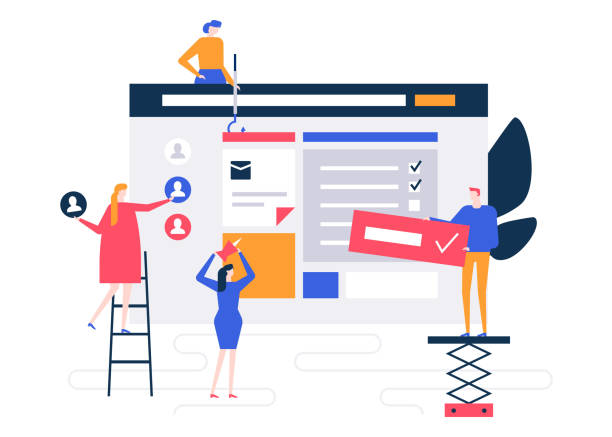Introduction to the Importance of Professional Website Design in the Digital Age
In today’s world, a powerful online presence is more vital than ever.
This is where the concept of professional website design becomes important.
A well-designed website is not just a digital storefront for your business, but a powerful tool for #marketing, #customer_communication, and #increasing_sales.
The first impression on your audience is made through your website, and if its design is not captivating and user-friendly, you will quickly lose valuable opportunities.
The goal of #professional_website_design goes beyond visual aesthetics; it includes #flawless_user_experience, high loading speed, security, and compatibility with various devices.
A professional website builds customer trust and enhances your brand’s credibility.
In contrast, outdated or poorly designed websites can harm your reputation and drive visitors away.
This is especially crucial for businesses looking to expand their market digitally, as ignoring this aspect means losing a significant market share and competitiveness.
Therefore, a proper understanding and investment in professional website design is a necessity, not a luxury.
This investment will yield high returns in the long run and help you stand out in today’s competitive world.
Are you worried about losing customers because you don’t have a professional e-commerce website?
With e-commerce website design by Rasaweb, forget these worries!
✅ Significant increase in sales and visitor-to-customer conversion rate
✅ Professional and user-friendly design that builds customer trust
⚡ Get free consultation from Rasaweb
Key Principles of Professional Website Design and User Experience (UX)
To achieve a professional website design, adhering to the key principles of User Experience (UX) and User Interface (UI) is of particular importance.
User experience refers to the user’s feelings and perceptions when interacting with your website, while user interface deals with the visual and interactive appearance of the site’s elements.
One of the most important principles is the responsiveness of the website, meaning the site must display correctly and maintain its functionality on various devices, including computers, tablets, and mobile phones.
High loading speed is also crucial; according to research, users tend to abandon sites that take more than a few seconds to load.
Optimizing images, using caching, and choosing suitable hosting can help with this.
Easy and logical navigation and routing are other principles; users should be able to find the information they need easily.
Using clear menus, relevant internal links, and a sitemap is very effective in this regard.
Content readability is also very important; choosing the right font, a readable font size, using enough white space, and proper paragraphing improve the reading experience.
Using clear and attractive CTAs (Call to Actions) guides users to perform your desired actions, such as subscribing to a newsletter or purchasing a product.
A professional website design always pays attention to these details to maximize user interaction and convert them into loyal customers.
Understanding and correctly implementing these principles is the cornerstone of any website’s success.
Choosing the Right Platform for Your Professional Website Design
When planning for professional website design, one of the most important decisions is choosing the right platform.
You have various options, each with its own advantages and disadvantages.
Content Management Systems (CMS) like WordPress, Joomla, and Drupal are among the most popular choices.
WordPress, due to its ease of use, high flexibility, and abundance of plugins and themes, is ideal for many businesses, including blogs, corporate websites, and online stores.
Joomla and Drupal are also powerful options but are usually preferred for more complex projects with higher security needs.
In contrast to CMSs, custom website development involves building the website from scratch with code specifically tailored to your needs.
This method offers infinite flexibility and is suitable for very specific or unique projects, but it is usually more expensive and time-consuming.
The choice of platform should be based on your budget, required scalability, technical knowledge level, and expected website features.
For instance, for a large online store, you might need solutions like Magento or WooCommerce, which is a WordPress plugin.
The table below provides a comparison between some of these platforms to help you in your decision-making for professional website design.
| Feature | WordPress | Joomla | Custom Development |
|---|---|---|---|
| Ease of Use | High (Beginner-friendly) | Medium (Requires learning) | Low (Requires developer) |
| Flexibility | Very High (Many plugins) | High (Components) | Infinite (Anything you want) |
| Development Cost | Medium (Themes and plugins) | Medium to High | High (Requires programmer) |
| Security | Medium (Improves with updates) | High | Depends on code quality |
| Suitable for | Blogs, corporate sites, small to medium online stores | More complex sites, portals | Specific projects with unique needs |
The Importance of SEO and Optimization in Professional Website Design
One of the main pillars of professional website design is paying attention to Search Engine Optimization (SEO).
Having a beautiful website without being visible in search results is like having a luxurious store in a remote desert.
SEO helps you rank high on Google and other search engines for keywords relevant to your business, driving more organic (free) traffic to your site.
This process includes two main parts: On-page SEO and Off-page SEO.
On-page SEO focuses on factors such as choosing appropriate keywords, optimizing titles and meta descriptions, URL structure, image optimization, and website loading speed.
Content optimization for target keywords, including their natural use in text, headings, and HTML tags, is vital.
On the other hand, Off-page SEO primarily deals with building links from other websites to yours, which helps increase site authority and ranking.
For a professional website design, SEO should be considered from the very initial stages of design, rather than being treated as a separate section after completion.
SEO-friendly URL structure, proper indexability by Google bots, and a sitemap are among the items that should be considered in the initial design.
Without attention to SEO, even the best professional website design may not achieve its business goals.
Is your e-commerce site ready to attract maximum customers and increase sales? Rasaweb transforms your online business with modern and efficient e-commerce website designs.
✅ Increased speed and improved SEO
✅ Excellent user experience on mobile and desktop⚡ Get free e-commerce website design consultation from Rasaweb!
Content is King: Content Strategy for Professional Websites
Content is the primary fuel for any professional website and a vital element for attracting and retaining an audience.
Alongside professional website design, a powerful content strategy plays a significant role in your online success.
Your content should not only be informative and high-quality but also address users’ needs and questions and engage them.
This includes various types of content: text (articles, product pages, blog posts), images (infographics, high-quality photos), videos (educational, promotional, behind-the-scenes), and even podcasts.
To start, you need to thoroughly identify your target audience and develop a content calendar based on their needs and interests.
Your content must be unique, valuable, and up-to-date.
Avoid plagiarism and try to offer fresh perspectives and useful information.
Educational content can introduce users to your products or services, entertaining content can humanize your brand, and analytical content can showcase your expertise.
In content creation for a professional website, storytelling also plays an important role.
Stories breathe life into your content and help it stick in the audience’s mind.
Don’t forget that your content should also be optimized for search engines to attract more visitors.
The relevance of content to your business goals and user needs is the key to success in this area.
Aimless and scattered content not only fails to help the site grow but may also confuse and discourage users.
Therefore, every piece of content you produce should be part of a comprehensive and purposeful strategy.
Click here to preview your posts with PRO themes ››
Website Security and User Data Protection
One of the most sensitive aspects of professional website design is its security.
In the digital age, cyber threats are increasing, and any security flaw can lead to the loss of sensitive information, damage to brand reputation, and even legal penalties.
Therefore, protecting user data and website infrastructure must be a priority.
The first step to enhance security is using the HTTPS protocol with an SSL certificate, which encrypts communication between the user’s browser and the website server, preventing information interception.
This is not only vital for security but also affects SEO rankings.
Regularly updating Content Management Systems (CMS), plugins, and themes is another preventive measure; many attacks occur due to vulnerabilities discovered in older software versions.
Installing and configuring a Web Application Firewall (WAF) can protect your website against common attacks like SQL injection and cross-site scripting (XSS).
Additionally, regular and automatic backups of all website data, including files and databases, are essential to ensure quick data recovery in case of any issues.
Using strong and unique passwords for all user accounts, restricting access, and regularly monitoring suspicious activities are also important security measures in professional website design.
Awareness of the most common vulnerabilities and taking necessary steps to counter them is an inseparable part of a secure and reliable website.
Investing in security is an investment in your business’s trust and stability.
Competitor Analysis and Identifying Strengths and Weaknesses in Website Design
To create a professional and distinctive website design, competitor analysis is a crucial step.
This process helps you not only become aware of industry best practices but also identify the strengths and weaknesses of competitor websites and discover opportunities for improvement for your own website.
Competitor analysis is not limited to observing the appearance of their websites; it involves a deep examination of their content strategies, SEO structure, user experience, technical performance, and even their business models.
Using tools like SimilarWeb, SEMrush, or Ahrefs, you can gather valuable information about competitor website traffic, the keywords they rank for, and their link-building strategies.
As part of this analysis, you should answer key questions: What content do your competitors produce that is well-received? What is their navigation structure like? Does their website perform well in terms of speed and responsiveness? What are their design or user experience weaknesses that you can improve upon? Visual analysis is also important; color palettes, fonts, images, and page layouts can be inspiring or indicate mistakes to avoid.
By gathering this information, you can formulate a website design strategy that not only meets your audience’s needs but also gains an advantage in the competitive market.
This analytical approach allows you to learn from competitors’ mistakes and implement innovations in your professional website design that will set you apart in the industry.
The table below provides a checklist for competitor website analysis.
Click here to preview your posts with PRO themes ››
| Analysis Factor | Review Details | Status/Notes |
|---|---|---|
| Design and User Interface (UI) | Aesthetics, color palette, fonts, layout, responsiveness | |
| User Experience (UX) | Navigation simplicity, loading speed, contact forms, purchase process | |
| Content | Quality, variety, audience fit, blog, articles | |
| SEO and Keywords | Target keywords, search ranking, backlinks | |
| Special Features | Online chat, e-commerce capabilities, reservation system | |
| Social Media Presence | Links to networks, activity level, engagement |
Digital Marketing and its Role in the Success of Professional Websites
After completing your professional website design, the next step is to attract traffic and convert visitors into customers.
This is where digital marketing comes into play and performs a vital role.
No matter how beautiful and functional a website is, without a strong digital marketing strategy, it will not be seen.
Digital marketing encompasses a set of online tactics and channels that help you introduce your website to your target audience and guide them towards making a purchase or taking desired actions.
Among the most important digital marketing strategies is Search Engine Marketing (SEM), which includes SEO and Pay-Per-Click (PPC) advertising on Google.
Additionally, content marketing, which was mentioned earlier, plays an important role in attracting an audience by producing valuable content.
Social Media Marketing (SMM) also provides an excellent opportunity for direct communication with customers, increasing brand awareness, and driving traffic to your website.
Email marketing is highly effective for maintaining communication with current customers and encouraging them to return to the website and make repeat purchases.
An integrated digital marketing strategy coordinates all these channels to reinforce each other and guide visitors through a logical sales funnel.
For example, your blog content can be shared on social media, and your email marketing can link to specific pages on your website.
Collaboration between the website design team and the digital marketing team is essential to ensure the website is optimized for marketing campaigns from the outset.
This coordination ensures that your professional website design is not only beautiful but also becomes a powerful tool for your business’s growth.
Did you know that 94% of users’ first impressions of a business are related to its website design? With professional corporate website design by **Rasaweb**, transform this initial impression into an opportunity for growth.
✅ Attract more customers and increase sales
✅ Build credibility and trust in the audience’s eyes⚡ Get free website design consultation!
Continuous Website Maintenance and Updates for Optimal Performance
Building a professional website design is only the beginning.
To maintain optimal performance, security, and relevance to user needs and search engine algorithms, continuous website maintenance and updates are essential.
Many businesses neglect this stage after launch, which can lead to a drop in SEO rankings, security issues, and poor user experience.
Website maintenance includes various tasks: software updates (CMS, plugins, themes) to fix bugs and security vulnerabilities, regular data backups to prevent information loss, and monitoring website performance in terms of loading speed and uptime.
Also, checking for broken links, which can disrupt user experience and harm site SEO, is of high importance.
Website content should also be periodically reviewed and updated to remain fresh and relevant.
Adding new content and removing old or obsolete content helps attract new traffic and maintain search engine rankings.
Take user feedback seriously and implement necessary changes to the website based on it to improve user experience.
Analyzing Google Analytics data can provide valuable insights into user behavior and help you identify and address website weaknesses.
Investing in maintenance and updates is, in fact, an investment in the longevity and success of your professional website design in the long term, ensuring your site always performs optimally and supports your business goals.
Click here to preview your posts with PRO themes ››
The Future of Professional Website Design and Emerging Trends
The world of professional website design is constantly evolving, with new technologies emerging and user needs changing, giving rise to new trends.
Understanding these trends is crucial for maintaining competitiveness and providing a forward-looking professional website design.
One of the most important current trends is Artificial Intelligence (AI) in web design.
AI-powered tools can automate the design process, provide personalized suggestions, and even generate content.
This can reduce the time and cost required for website design and allow for greater personalization.
Voice Search is also growing, and professional websites need to be optimized to respond to this type of search, which includes using more natural language in content and optimizing for long-tail keywords.
Progressive Web Apps (PWAs), which offer a user experience similar to native mobile applications through the browser, are also expanding.
These technologies can improve speed, offline capabilities, and access to notifications.
Dark Mode has become a popular feature due to its visual benefits and battery saving, and many websites are now offering this option.
Additionally, designs based on micro-interactions, which include small details like visual feedback upon clicking or subtle animations, help improve user experience and increase site appeal.
In the future, we will see websites that are smarter, more personalized, and more adaptable to individual user needs.
Embracing these trends and incorporating them into professional website design will be key to success in tomorrow’s digital ecosystem.
Frequently Asked Questions
| Question | Answer |
|---|---|
| What does professional website design mean? | Professional website design refers to creating a user-friendly, visually appealing, fast, secure, and search engine-optimized website that meets business objectives. |
| What are the most important features of a professional website? | Responsiveness, high speed, security, SEO-friendliness, excellent User Experience (UX) and User Interface (UI), high-quality content, and strong branding. |
| Why is responsive design crucial for a professional website? | Responsive design ensures that your website displays correctly on any device (computer, tablet, mobile), which is very important for user experience and Google ranking. |
| What is the role of UI and UX in professional website design? | UX (User Experience) focuses on ease of use and user satisfaction, while UI (User Interface) deals with the visual appearance and user interaction with the website. Both are essential for attracting and retaining an audience. |
| What is the place of SEO in professional website design? | SEO is one of the main pillars. A professional website must have a strong technical structure, optimized content, and high speed to achieve a good rank in search engine results and be seen. |
| What tools or platforms can be used for professional website design? | Content management platforms like WordPress, Joomla, or Drupal; web development frameworks like React, Angular, or Vue.js; and graphic design tools like Figma or Adobe XD. |
| What are the main steps in designing a professional website? | Planning and research, wireframe and mockup design, development and coding, content entry, testing and review, and finally launch and maintenance. |
| What is the importance of security in a professional website? | Website security is very important for protecting user data and business reputation. Using SSL/TLS, firewalls, regular backups, and updates are vital measures. |
| Does a professional website require maintenance after launch? | Yes, regular maintenance including software updates, checking for broken links, performance monitoring, backups, and adding fresh content is essential to maintain website functionality and ranking. |
| What distinguishes a professional website from an amateur one? | A professional website focuses on business objectives, provides an exceptional user experience, adheres to high technical standards, and is continuously optimized for improvement, while an amateur website usually lacks these features. |
And other services of Rasaweb Advertising Agency in the field of digital advertising
Smart Digital Branding: An effective tool for online growth with attractive UI design.
Smart Advertorial: An effective tool for campaign management with SEO-driven content strategy.
Smart Direct Marketing: Designed for businesses seeking digital branding through user experience customization.
Smart UI/UX: Professional optimization for campaign management using custom programming.
Smart Advertorial: Professional optimization for increasing click-through rates using real data.
And over a hundred other services in the field of internet advertising, advertising consultation, and organizational solutions
Internet Advertising | Advertising Strategy | Advertorial
Resources
Principles of Professional Website Design in Iran
Rayan Site Website Design Services
The Importance of User Interface in Web Design
How to Build a Website?
? For your business to shine in the digital world, Rasaweb Afarin Digital Marketing Agency, specializing in professional website design, SEO, and comprehensive digital marketing strategies, paves your path to success.
📍 Tehran, Mirdamad Street, next to Bank Markazi, Kazeroun Jonoubi Alley, Ramin Alley, No. 6











